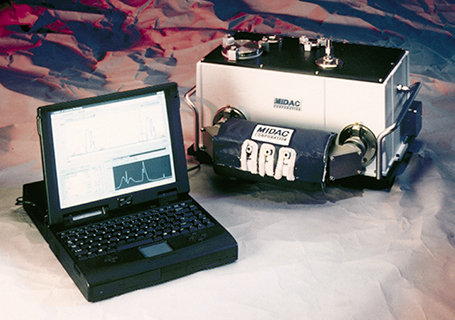Eyeing the Invisible
Software tools to monitor vapor concentrations using Fourier Transform Infrared (FTIR) spectroscopy received an assist by way of a nonreimbursable Space Act Agreement between the Kennedy Space Center (KSC) and the MIDAC Corporation of Irvine, California.
The agreement which was initiated in 1995, was established to encourage software improvements to an FTIR spectrometer. This vapor monitoring hardware is on duty at KSC's Space Station Processing Facility. Ammonia is called for in the current International Space Station design, to be used as a refrigerant. Ammonia must be closely monitored during loading and storage due to its toxic and flammable nature.
Infrared technology, like the FTIR, allows the invisible to be seen. Invisible vapors can be measured by this technology because each compound absorbs certain frequencies in the infrared spectrum. These absorbed frequencies uniquely identify each compound, like a fingerprint.
Prior to the collaboration between KSC and MIDAC, one of the company's instruments was in demand, utilized in contamination and toxic vapor detection studies. Sample measurements would be churned out in raw form by the equipment. This basic data would be fed into an external computer. It would transform the raw interferogram information into information concerning what compounds, and how much of each, were being measured in the sample.
Kennedy Space Center lab technicians installed a small computer inside the MIDAC FTIR instrument. The KSC specialists also developed the software code for calibrating the monitor to recognize and measure a given infrared-active gas or vapor. A runtime code for operating the vapor monitor was devised. This augmentation of the FTIR, outfitted with an embedded computer and special software, could then produce a list of compounds and their concentrations, instead of the raw unprocessed data.
A number of troublesome factors were eliminated by the new software coding, such as temperature drift of the FTIR, the effects of optical degradation. Improved sensitivity of the device was attained, despite wide fluctuations in environmental conditions during system operation. Data stream output to a communications port was produced in an easily readable format.
The Space Act Agreement allowed for these codes to be polished into a commercial grade product, of value to both NASA and MIDAC. That commercial software package has been furnished to NASA and is also now incorporated in the MIDAC line of products.
KSC's Contamination Monitoring Laboratory designed, fabricated, and delivered a Portable Ammonia Monitoring System with the new software. Called the Ammonia Detection Cart, it has been used during validation testing of the Ammonia Servicer in the Space Station Processing Facility. This servicer contains and controls the ammonia loaded into space station elements. The final versions of the cart have been delivered for environmental area monitoring during the processing of Space Station elements that are to carry liquid ammonia. Capabilities of the cart have also been demonstrated for alcohols, Freons, ketones, water vapor, carbon dioxide, and the like.
MIDAC's FTIR technology has proliferated in use over the years, particularly in industrial process applications where emission rates must be measured. MIDAC offers a range of rugged, high performance spectrometers and components to customers. An arsenal of analytical tools has been crafted for virtually any gas analysis needed, capable of working in real-world environments. MIDAC instruments are built to provide fast and easy access to accurate data.
MIDAC systems are providing critical data in a variety of areas including: environmental monitoring, process optimization and control; applications for semiconductor manufacturers; fenceline monitoring of industrial facilities; rocket plume analysis; and studies of volcanic emissions.

"Fingerprinting" types of chemicals and their amounts permits effective emission monitoring, protects the environment, ensures health and safety of workers, and provides cost savings in the manufacturing process.













